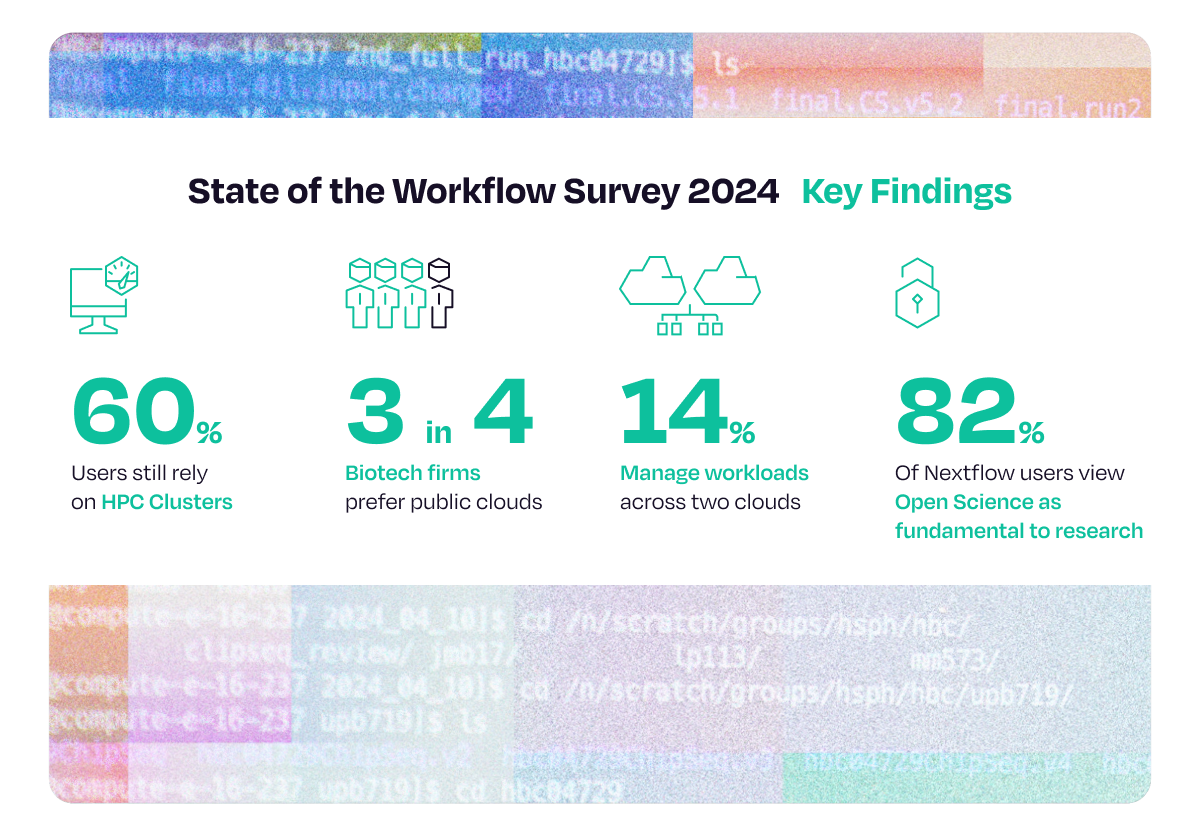Understanding the Nextflow User Community
In April, we conducted our annual State of the Workflow Community survey to gather insights and feedback from the Nextflow user community, and we are excited to share that this year, 600+ Nextflow users participated - a 21% increase from 2023! By sharing these insights, we aim to empower researchers, developers, and organizations to leverage Nextflow effectively, fostering innovation and collaboration amongst the community. Here we share some key findings from the Nextflow user community.
DOWNLOAD THE FULL SURVEY
Key Findings At a Glance
✔ Shift from HPC to public cloud - Majority of biotech and industrial sectors now favor public clouds for running Nextflow, with 78% indicating plans to migrate in the next two years.
✔ Multi-cloud deployments are on the rise - To meet growing computational and data availability needs, 14% of Nextflow users manage workloads across two clouds.
✔ Open Science is key for streamlining research - 82% of Nextflow users view Open Science as fundamental to research, advancing science for everyone.

Bioinformatics Analysis is Moving to Public Clouds
In recent years, we have witnessed a notable shift in bioinformatics analysis towards public cloud platforms, driven largely by for-profit organizations seeking enhanced reliability, scalability and flexibility in their computational workflows. Our survey found that while on-premises clusters remain the most common for users in general, the prevalence of traditional HPC environments is on a steady decline. Specifically, in the biotech industry, nearly three-quarters of firms now favor public clouds, reflecting a broader industry trend toward adaptable and robust computing solutions.
Multi-Cloud Deployments are Rising
As the industry continues to scale their workflow, they are increasingly adopting multi-cloud strategies to meet the demands of diverse computational workflows. In 2021, just 10% of cloud batch service users were running workloads in two separate clouds. By 2024, this figure had risen to 14%. Additionally, 3% of users utilized three different cloud batch services in 2021, which increased to 4% by 2024. This trend highlights the move towards deploying across multiple cloud providers to address bioinformatics' growing computational and data availability needs across various regions and technical complexities.
Open Science: Advancing Science for Everyone
Open Science has emerged as a transformative approach within the bioinformatics community, significantly enhancing collaboration, efficiency, and cost-effectiveness. Around 82% of survey respondents emphasized the fundamental role of Open Science in their research practices, reflecting strong community endorsement. Additionally, two-thirds reported significant time-savings through Open Science and 42% acknowledged the financial benefits, highlighting the value of transparency in research. This shift fosters effective knowledge sharing and collaborative advancement, accelerating research outcomes while reinforcing accountability and scientific integrity.
Read the Full Report Now
Our 2024 State of the Workflow Community Survey provides insights into the evolving landscape of bioinformatics and scientific computing. The shift towards public and multi-cloud platforms, combined with the transformative impact of Open Science, is reshaping the Nextflow ecosystem and revolutionizing computational workflows. Embracing these trends not only drives innovation but also ensures that scientific inquiry remains robust, accountable, and accessible to all, paving the way for continued progress in bioinformatics and beyond.
Dive into the full report to uncover further insights on how bioinformaticians are running pipelines, the pivotal role of the nf-core community, and other key trends —your glimpse into the future of computational workflows awaits!
